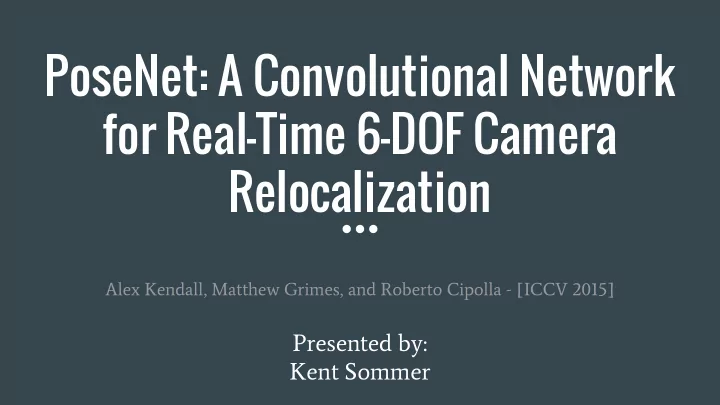

PoseNet: A Convolutional Network for Real-Time 6-DOF Camera Relocalization Alex Kendall, Matthew Grimes, and Roberto Cipolla - [ICCV 2015] Presented by: Kent Sommer
Outline: ● Motivation / Related work ● Problem Statement / Overview of approach ● Dataset ● Details and issues with approach ● Results ● Conclusion / Quiz
Review and Related Work
Review: ● Two approaches to localization ○ Metric ■ Estimate continuous position ○ Appearance/Topological ■ Classify scene to limited number of discrete locations
What does this have to do with search? ● Appearance/Topological localization can be presented as a search problem! ○ Database of known locations, given an input image, where are we? ■ Efficient retrieval is necessary, usually really large database
Related Work: ● Scene Coordinate Regression Forests ○ Use depth images to map each pixel from camera to global ○ Train a regression forest to regress these labels given an RGB-D image. ○ Limited to indoor use in practice (IR interference)
Related Work: ● Feature extraction and matching as in [1, 2, 3, 4] ○ (Generally) extract various types of image features ■ Match these features with those in the database with tagged known location to return position [1] J. Wang, H. Zha, and R. Cipolla. Coarse-to-fine vision-based localization by indexing scale-invariant features. Systems, Man, and Cybernetics, Part B: Cybernetics, IEEE Transactions on, 36(2):413–422, 2006. [2] Y. Li, N. Snavely, D. Huttenlocher, and P. Fua. Worldwide pose estimation using 3d point clouds. In Computer Vision– ECCV 2012, pages 15–29. Springer, 2012. [3] Q. Hao, R. Cai, Z. Li, L. Zhang, Y. Pang, and F. Wu. 3d visual phrases for landmark recognition. In Computer Vision and Pattern Recognition (CVPR), 2012 IEEE Conference on, pages 3594–3601. IEEE, 2012. [4] A. Bergamo, S. N. Sinha, and L. Torresani. Leveraging structure from motion to learn discriminative codebooks for scalable landmark classification. In Computer Vision and Pattern Recognition (CVPR), 2013 IEEE Conference on, pages 763– 770. IEEE, 2013.
Problem Statement and Overview of Approach
Problem Statement: ● Estimate the 3D position and orientation of the camera, given a single monocular image taken from a large previously explored area ● Green ○ Training ● Blue ○ Testing ● Red ○ System output
Overview of Approach: ● Perform end-to-end supervised learning with euclidean loss to regress 6-DOF pose. ○ Does not require large landmark database (instead it learns robust high level features to regress 6-DOF pose.)
Dataset
Dataset:
Details and Issues with Approach
Details of Approach (Neural network): ● PoseNet is a modified version of Googles 22 layer Inception Network (27 if counting pooling layers) ○ Includes 6 ‘inception modules’ and 2 additional intermediate classifiers which are discarded during testing
Details of Approach (Neural network): ● Modifications to LeNet ○ Replace all softmax classifiers with affine regressors ○ Insert another fully connected layer with size 2048 before the final regressor (used for generalization exploration) ○ At test time, normalize quaternion orientation vector to unit length ● Results in a 23 layer (28 layers including pooling) network
Details of Approach (Neural network): ● Euclidean Loss / Affine Regressor layers layer { layer { name: "loss3/loss3_xyz" name: "loss3/loss3_wpqr" type: "EuclideanLoss" type: "EuclideanLoss" bottom: "cls3_fc_xyz" bottom: "cls3_fc_wpqr" bottom: "label_xyz" bottom: "label_wpqr" top: "loss3/loss3_xyz" top: "loss3/loss3_wpqr" loss_weight: 1 loss_weight: 500 } }
Details of Approach (Neural network): ● Learning location and orientation ○ Train network on Eucliden loss ○ Found that training on just position or orientation performed poorly compared to training on both simultaneously
Details of Approach (Neural network): ● Learning location and orientation ○ Balance must be struck between orientation and translation penalties. ○ Optimal given by ratio between expected error of position and orientation at the end of training (not beginning
Details of Approach (Neural network): ● PoseNet model was implemented in Caffe and trained using stochastic gradient descent ○ Base learning rate was 10^-5 ■ Reduced by 90% every 80 epochs ○ Momentum of 0.9 ○ Batch size of 75 ○ Subtract separate image mean for each scene
Issues with Approach: ● Starting network weights (LeNet pretrained on XX) are very important for PoseNet performance
Issues with Approach: ● No output uncertainty produced by network ● Relatively large error compared to SCoRe Forest (indoors - as SCoRe Forest cannot handle the large outdoor datasets) ● Even utilizing transfer learning yields semi-long training times (3-6 hours on Nvidia Titan X)
Results
Results:
Results:
Conclusion
Conclusion / Summary: ● PoseNet is an end-to-end 6DOF pose regression convnet ● 5ms run-time, 50MB total storage space ● Large Scale indoor and outdoor relocalization ● Release of public dataset consisting of over 10,000 pose annotated images
Thanks! Questions?
Quiz
Quiz: 1. PoseNet is able to output uncertainty a. True b. False 2. PoseNet is based off which of the following models? a. VGG16 b. AlexNet c. LeNet d. ResNet
Recommend
More recommend